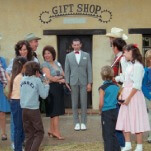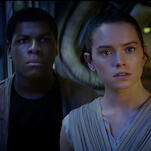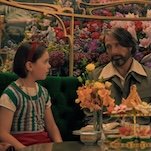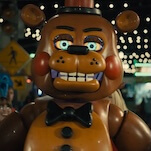Abbas Kiarostami shared Cannes glory with another departed master

Taste Of Cherry (1997) and The Eel (1997)
Abbas Kiarostami made difficult films. That’s not a criticism, just an observation—one that hasn’t been made too often since we lost the great Iranian director to cancer a couple of weeks ago. Critics, grieving colleagues, and other eulogizers have understandably focused on his humanism, his formal prowess, and the eclecticism of his body of work. But the difficulty of that work is key to its vitality, its importance. Kiarostami challenged. His movies sometimes omitted the kind of plot elements—backstory, resolution, normal character psychology—that audiences almost innately expect. And there were times when they seemed to contradict the very definition of a movie, creating what felt like a new relationship between the images on screen and those watching them. Like most of the greats, Kiarostami helped reshape our understanding of how movies work. That could be an uncomfortable process, even for those receptive to it.
Taste Of Cherry was my first taste of Kiarostami. I watched it in a college classroom, with a group of fellow students who seemed evenly split down the middle on the film—some were fascinated by it, others responded like the bored, hostile crowd that greeted Antonioni’s L’Avventura at Cannes. I’m embarrassed to admit that, at the time, I was probably closer to the latter camp than the former on this mysterious drama, set mostly within the front seat of an automobile, driving in circles around a dusty, nondescript location. While Taste Of Cherry received plenty of instant adoration, and has since secured its position in the canon, it wasn’t just bewildered college kids like myself that were skeptical of its merits. When the film opened in America in the winter of 1998, Roger Ebert issued a dismissive pan, lambasting it as “excruciatingly boring.” He saw an emperor without clothes—not the last time a detractor would apply this particular critique to the director.
Taste Of Cherry was divisive at Cannes, too, where it premiered in May of 1997. (The festival and Kiarostami often clicked: Several of his movies screened there over the years, and he served on a jury four times.) The film was a late entry, smuggled onto the competition lineup—a last-minute addition that many journalists attributed to problems with Iranian authorities, but which Cherry superfan Jonathan Rosenbaum revealed had more to do with a law prohibiting Iranian films from premiering outside of the country. Kiarostami arrived to a standing ovation (“just for showing up,” the New York Times clarified), but Ebert reported a mix of boos and cheers when the lights came up. Taste Of Cherry was not heavily favored to win the Palme D’Or, much less to split it with another film no one was predicting for the top prize. So there was some surprise, then, when the official jury (led by French actress Isabelle Adjani) announced that they were handing the Palme to both Taste Of Cherry and Japanese director Shohei Imamura’s The Eel—a shared victory Kiarostami celebrated by giving another French actress, Catherine Deneuve, a controversial peck on the cheek.
To hear some tell it, the awarding of the Palme to these “two quiet, pensive films” was Cannes’ way of reasserting “its claim to seriousness” after an especially glitzy, star-powered 50th edition. The festival had marked its anniversary with predictable extravagance: A record $6.5 million was spent on the event, which drew major stars—Michael Jackson, Johnny Depp with then-girlfriend Kate Moss, the Spice Girls—to the French Riviera, alongside a deep guest list of surviving Palme winners. (Notably not in attendance was Ingmar Bergman, who once called the fest “a place of mental humiliation” and who evidently could not be lured back, even with longtime muse Liv Ullmann premiering a film in Un Certain Regard and the festival handing him the Palm Of The Palms, which was a kind of lifetime achievement award for directors who never won the top prize at Cannes.)
But what of the official competition lineup? “Slightly rusty,” opined The Economist. “Very average,” agreed French magazine Positif. Kenneth Turan of the Los Angeles Times went further, calling it “the weakest in memory.” Hindsight is, of course, 20/20, but what movies were these critics watching? Cannes 1997 had its duds, as every festival lineup does, but it also had Wong Kar-Wai’s glorious breakup ballad Happy Together, Ang Lee’s appropriately chilly domestic drama The Ice Storm, Curtis Hanson’s gangbusters prestige noir L.A. Confidential, and one of the most harrowing acts of audience antagonism ever, Michael Haneke’s Funny Games. There was also Atom Egoyan’s magnificent The Sweet Hereafter, which many critics named the frontrunner for the Palme. Not for nothing did Indiewire later call this one of the 10 best lineups in Cannes’ storied history.
When a festival splits an award between two movies, it’s often assumed to be a sign of disagreement among those deliberating—a way to appease the multiple factions within a hung jury. All the same, Taste Of Cherry and The Eel share common ground, some elements that make them feel like paired prizewinners. Both prominently concern suicide. Both feature protagonists with deliberately ill-defined biographies, struggling in self-imposed solitude: one trying to start over, the other contemplating the end of his life. Both are by filmmakers, now deceased, who blurred the lines separating fiction from nonfiction. And neither film made much of a commercial impact when they belatedly opened in the United States—though that’s true, alas, of many Palme winners.
Calling them both “quiet” and “pensive,” as the New York Times did, is a little misleading, however. The Eel looks like a Hollywood blockbuster compared to Taste Of Cherry; it has fistfights and a love story and a murder. The film begins at a height of sensationalism, as Takuro (the great Kôji Yakusho, from Shall We Dance?, 13 Assassins, and several Kiyoshi Kurosawa films) responds to an anonymous tip and returns home early from a fishing trip to find his wife in bed with another man. He savagely stabs her to death, blood splashing theatrically onto the camera lens, before calmly turning himself in to the authorities. Flash forward eight years, and Takuro, fresh out of the slammer, is opening a coastal barbershop and mostly keeping to himself, in hopes that his dark past can stay behind him. His closest confidante is a pet eel he adopted in prison, with which he carries on one-sided conversations. “He listens to what I say,” Takuro reasons. “He doesn’t say what I don’t want to hear.”
The Eel, in other words, is an ex-con drama, the kind in which a weary felon, having paid his debt to society, struggles to reintegrate into life on the other side of the bars. It’s just an especially idiosyncratic, even quirky addition to the genre—and not just because the main character delivers dialogue to a slimy sea creature. Imamura, a previous Palme winner for 1983’s more sweeping The Ballad Of Narayama, augments his initially low-key narrative with dream sequences, hallucinations, and a couple of chaotic, knock-down-drag-out confrontations, including a single-take brawl between Takuro and a former prison-mate, some of whose appearances may or may not be a figment of our hero’s imagination. The Eel is often quite pleasant to look at, with Imamura reveling in the dawn-and-dusk glow of his seaside scenery.
Part of the New Wave of Japanese cinema, which blossomed from the late 1950s until the early 1970s, Imamura built his reputation partially on stories about strong women struggling against the limitations and restrictions of Japanese culture. The Eel doesn’t quite fit into that tradition, however. Besides the philandering wife, dispatched in the opening minutes of the movie, the only prominent female character is Keiko (Misa Shimizu), a young woman who begins working at Takuro’s barbershop after he rescues her from a suicide attempt. Like past Imamura heroines, she’s hit with various hardships—a rape attempt, an unwanted pregnancy, harassment from her loan-shark former lover—but still seems to exist primarily as a plot device of Takuro’s story, serving as not just a potential love interest but also a symbol of the brighter future he could have if he could just move beyond his troubled past. There’s a case to be made that The Eel is about emasculation in Japanese society, which would make Keiko the “solution”: a damsel to be rescued and a loyal woman patiently packing lunches for the man whose crime she rather quickly overlooks.








































